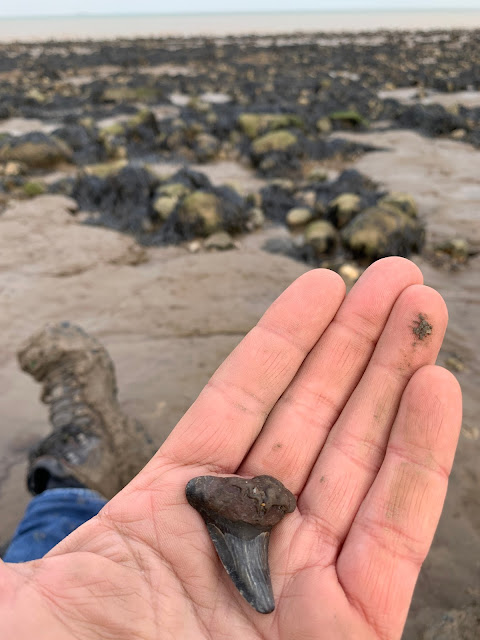I spent the first session just trying to get some bearings and work out the techniques involved. There are basically two main techniques for finding fossils here 1) Scouring the foreshore on your hands and knees, looking amongst the shingle and pyrite nodule accumulations for fossils which have been washed out the cliffs and 2) Checking for phosphatic nodules anywhere below the high water mark at low tide which may contain fossilised crabs and lobsters and even (rarely) birds. Before I visited I joined a few facebook groups including London Clay Fossils Here and Sheppey Fossil Forum Here, read the information on the Sheppey Fossils website Here and also watched some Sheppey Fossil hunting You Tube videos Here. I also bought the excellent book London Clay Fossils of Kent and Essex by Rayner et al Here.
I found a few bits, the highlight was a shark tooth which I believe is Otodus obliquus, an extinct species/genus, dating in this area from about 52 million years ago in the Lower Eocene. I also found a few gastropods and lots of unidentified fragments. The London Clay in this area represents an assemblage of organisms associated with a warm tropical sea with a land mass nearby dominated by crabs. lobsters, sharks, rays, turtles, fish with the occasional bird and snake and mammal washed in from the nearby landmass.
In the late afternoon I went to the Capel Fleet Raptor view point for a bit of modern day bird action with the raptors coming into roost. Had 10 Marsh Harrier, 1 Hen Harrier, 2 Merlin, 1 Great Egret and 35 Corn Buntings.
Otodus tooth
Lots of gastropods and also what might be a lobster borrow (bottom), trace fossils (bottom left), maybe a coprolite (right) and maybe a seed (middle left of maybe a bit of fossil wood). I will check these with the facebook group but thought I would put down my guesses first as could be useful for absolute beginners like myself in the pitfalls and fossil lookalikes .
Warden. The toe of a clay landslip which I presumed was a good place to check the foreshore here for any fresh washed out fossils. It was in this area I found the shark tooth.
Brents were feeding off shore and there were Sanderlings running around the foreshore where I was fossil hunting
Marsh Harrier coming into roost nearby at Capel Fleet
Corn Buntings coming into roost at Capel







2 comments:
Peter - if you're after a fossil bird from the London Clay there is no better place than Walton on the Naze in Essex. The late Michael Daniels collected over 700 associated sets of bones and partial skeletons from this site, sometimes finding 20-30 birds each winter. I've spent considerable time collecting on the North Kent coast (it's my other hobby apart from birding!) and have found bird remains to be really quite difficult to find, with anything associated/articulated being vanishingly rare... The collecting technique at Walton is a bit different in that you're mainly looking for bluish lenses of clay containing charcoal and bone fragments sticking out of the wave-cut platform and lower cliff (thought to represent forest debris that was washed out to sea) which you then scoop out with a trowel, and take home to dry and then to sieve out the bird remains, which are loose in the clay, pale brown and rather fragile. It's well worth checking out, some amazing stuff has been found there, much of which remains undescribed.
That's the next destination on the list Thomas. Interesting that the technique is different there - thanks a lot, will focus on that when I visit.
Would certainly be interested in what you've found in the London Clay in the past. Anything online?
Post a Comment